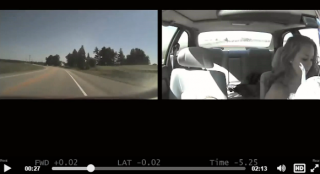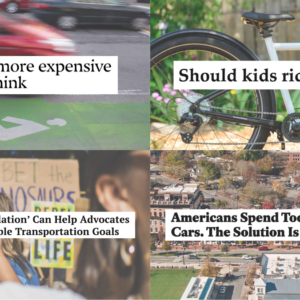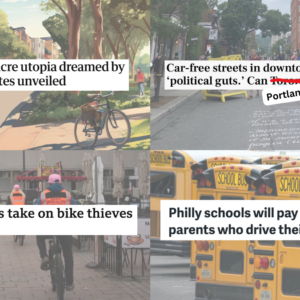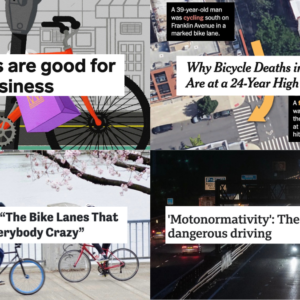
(Image: AAA Foundation for Traffic Safety)
This week’s Monday Roundup is sponsored by Laughing Planet, where you can now get food delivered by bike in downtown Portland.
Here are the bike-related links that caught our eyes this week:
Distracted driving: A AAA study put video cameras into teen drivers’ cars to study the moments just before 1,700 collisions. More than half of drivers were distracted just before moderate and severe crashes, but only 12 percent by telephones.
Reflective spraypaint: With bike safety in mind, Volvo has created a spray-on substance that is “completely invisible until it’s hit by the glare of a car’s headlights.”
Parking revolutionary: Donald Shoup, the UCLA professor who sounded the national alarm about the cost of free parking, will hold his retirement party on top of a parking structure.
Hit-and-run consequences: In the six years since a Vancouver 18-year-old became the first Washingtonian imprisoned for vehicular homicide, a 2009 hit-and-run case caused by his texting behind the wheel, his life has descended into a string of apparently nonviolent criminal charges.
Fashion felonies: “Now people need special costumes to ride bicycles. I mean, a helmet, what, are you an astronaut??” That’s inimitable fashion maven Fran Lebowitz, who also claims that her glasses cost as much as a car.
Gee thanks Google: Its driverless cars will have external airbags.
Scofflaw reasons: The top three reasons people break laws while biking, a recent study found, were “poor infrastructure design,” “the speed of motorised traffic” and “the behaviour of other road users.”
Bike licensing: Chicago Magazine rounds up the many examples of it not working, but adds that a bike-related tax could help fund the two things that actually improve biking safety and behavior: bike infrastructure and bike education.
Equity tips: To start thinking about the causes of disparities, try to “ask ‘why?’ approximately five times.” And four other suggestions for improving racial equity in the biking movement.
Black in Portland: Bikes are clearly used as a symbol of change in a powerful video interviewing several people about what the generation-long displacement of black Portlanders from inner North and Northeast has felt like.
Near misses: A British website is the latest to compile and analyze narrowly avoided bike collisions.
Paris pollution: Paris is rationing car use and making bike-sharing and other public transit free in a fight against some of the world’s dirtiest air.
Advertisement
Bike agenda: Hillsboro’s city council has put better biking and walking infrastructure on its list of 11 priorities for the year.
Car-free commerce: As Stockholm closes some major commercial streets to cars, a consultancy group scoured the numbers and concluded that “car accessibility did not have a significant effect on apartment prices or office rents.”
Seattle woonerf: Property values are up along Bell Street Park, Seattle’s attempt at shared street space. CityLab looks at it and five other woonerfs worldwide.
Auto-only funding: Two months after someone asked them to, Five Republican congressmen have introduced the so-called DRIVE Act, which would end federal gas tax spending on “bike paths, sidewalks, mass transit, and other local projects.”
Protected lane: After years of debate, Boston will add curb-protected bike lanes, including protected intersections, to a 2/3-mile stretch of Commonwealth Avenue. Some call it an “outrage”; others disagree.
And in your video of the week, a mixed-bag milestone: Sunday Parkways (not to mention a tallbike, a recumbent, a longtail and a pennyfarthing) made it to The Simpsons.
If you come across a noteworthy bicycle story, send it in via email, Tweet @bikeportland, or whatever else and we’ll consider adding it to next Monday’s roundup.






Thanks for reading.
BikePortland has served this community with independent community journalism since 2005. We rely on subscriptions from readers like you to survive. Your financial support is vital in keeping this valuable resource alive and well.
Please subscribe today to strengthen and expand our work.
Regarding distracted driving: it seems as though every article about this subject focuses heavily on electronic devices; in reality, most of the distracted drivers I see are simply not paying attention. The same goes for some pedestrians and cyclists too.
***comment deleted because it was out of context, served no productive purpose and was only meant to antagonize***
sarcastic remarks can be amusing, but data are probably more useful.
“between 1995 and 2009, 60 percent of fatal New York City pedestrian and cyclist crashes with known causes were the result of motorists breaking traffic laws.”
If I am reading the report correctly, when you add in serious injuries, the share of the carnage for which drivers are responsible goes up:
“Driver inattention caused 36 percent of crashes that killed or seriously injured pedestrians. Failure to yield resulted in 25 percent of crashes. High speeds caused 20 percent of these crashes.”
http://www.streetsblog.org/2012/08/06/ta-most-city-pedestrians-and-cyclists-killed-by-drivers-who-broke-the-law/
(& from Monday Roundup Nov. 29, 2010)
Researchers in Melbourne found that in the course of a study http://tinyurl.com/czcoakp using helmet cameras in city traffic, the person in the car was at fault for 87% of the collisions and near-misses they observed.
Pointless, antagonizing, irrelevant statements that have zero context to the discussion– what other reason are you moderating this site for, Jonathan?
Thank you lyle for letting me know. I’ve edited the comment.
Sweet!
Democracy!!!
Seriously, I’m not one to usually scream for moderation, but that was past the pale and totally ridiculous. Thanks.
Democracy? Your “scream” for censorship and the subsequent obliteration of that comment was hardly democracy in action. The guy’s comment may have been boorish but it never came close to being abusive, profane or insulting. Your “scream” did, however, deny other participants to read it and decide for themselves. Shameful what passes for moderation around here.
Wise people are foolish if they cannot adapt to foolish people.
–Michel Eyquem de Montaigne
I read it and it was pointless and lame. Not worth discussion.
Then can we just leave it, let people ignore it, and not be offended by everything little thing?
I moderated a forum for a few years. It’s hard. If you let lots of stuff go it always escalates, but if you moderate all the little stuff it starts to look like censorship. Jonathan does a pretty good job considering how hard it is to walk the line. It’s impossible to make everyone happy or be perfect. The only proof of success is how popular the forums are.
I’m also not sold on the AAA’s focus on “teenage” distracted driving. Almost all drivers that I see playing with their phones are over the age of 19. A few months ago I watched a woman in a Prius weaving up to a red light and stopping halfway into a wide bike lane. I rode up beside her and stopped and looked in, and not only was she trying to text, she was an older woman wearing what appeared to be thick reading glasses! When I tapped on her hood to get her attention, she took them off to look at me… that’s when I simply pointed out where the front of her car was and she seemed quite surprised.
Its a moral panic.
Bad drivers and distracted drivers have existed for a very long time. (probably since the domestication of the horse!). We’ve never been able to increase driver training like Europe though. Cellphones have given us a new distraction, but it was new technology, so we could get people worked up about it. People are already afraid of new technology, cell phone bans went in much faster than drunk driving laws.
I remember being in a school bus, watching a guy reading in a red convertible on the highway.
And reading while driving remains legal! 😉
Fund bike and drivers’ education directly from the ticket fines.
Two items here suggesting bike infrastructure is something that should be funded analogous to car infrastructure miss the elementary fact that bike infrastructure is derivative; is only required because the overwhelming presence of *cars* make biking so dangerous.
For clarity: educational funding to prevent automobile drivers from being hazardous should come from citation fines for drivers being hazardous. That’s the stick.
The carrot: for a 25% reduction in the fine the guilty driver can pay the fine directly to a 3rd party remedial driver training company.
The citation issuing authority would get enough of the fine to cover officer time spent not performing other duties.
Schools with high recidivism rates would become unauthorized vendors as would the trainers, managers and thosr those who take payments directly themselves.
The schools would be encouraged to lobby for increased fines for certain violations IF they can show that the increased revenue is needed to reduce recidivism.
Automobile insurance companies would be encouraged to run these schools directly.
Automobile insurance companies would further be encouraged to mandate that their covered drivers that are repeat/multiple offenders have ODB-2 tracking recorders installed in their vehicles. For drivers that refuse the insurance companies would be given the option of immediately canceling or raising the price of that dtiver’s policy.
This is a great idea!
I’d also love to see a massive expansion of the program in Portland where your first ticket can be waived in lieu of a small fee and a driver and bicycle safety course. Fines can be paid and tickets forgotten about, but education is extremely valuable for everyone.
I remember Cellestine’s sentencing very clearly. I got into a minor debate with Dave Moulton (of Moulton Bicycles) about the use of the word “accident.” At the time I predicted:
“This was not an “accident” on [Cellestine’s] part, because he knew the dangers of driving while severely distracted. And it was not an “accident” on the part of the State of Washington, who damn well knew he was a menace but failed to keep him off the road, and will fail to do so again in 2-5 years. So not only was Mr. Cellestine’s “accident” completely foreseeable, I’ll go one better and foresee his next potentially fatal “accident”, unless Washingtonians get their crap together, pass some tough laws and tighten up their licensing requirements.”
( http://axoplasm.com/web-log/when-“accident”-not-“unintentional”/ )
So it’s five years later, and it appears Cellestine served … a few months? For MURDER? … and waddya know:
“A few months after the early completion of his sentence for Patterson’s hit-and-run death, Cellestine violated conditions of his release and committed new traffic offenses, including attempting to elude a pursuing police vehicle and driving with a suspended license.”
We accept way too much of this bull$#!&.
Not disagreeing with anything else you said, I don’t think causing death through willful negligence constitutes “murder”.
Teenagers are not ready for driving. Most adults are not either. Driver education is a joke in this country.
Humans are not emotionally capable of the responsibility of driving. I am reminded of this on the days I drive to work and observe the angered reactions to simple behaviors that lead to people feeling violated Most of the time there is some type of revenge behavior for having been violated. You know, two wrongs makes a right.
With the exception of allowances for rural areas (via application to explain why), driving shouldn’t be allowed until the age of 18.
Seattle’s attempt at shared street space is just that, an attempt. It falls on its face due to the fact that it’s also a major bus route as well as a popular connection to get to two highways, and diverter ‘turn-only’ signs for private autos are ignored.
Re: Volvo reflective spraypaint: Per the comments section in the link, “This is pretty much like fraternities selling rape whistles.”
Especially with all the lovely distractions they’re currently adding to their dashboards.
It’s not even paint. Article says it is water soluble and lasts “ten days.” How long will it last in a Portland downpour when you really need it?
Could be fun at WNBR….
External airbags… hmph… looks like a way to slam a pedestrians’s head into the hood of the car, or onto the pavement, while protecting the ankle from being bruised…
Don’t diss external airbags and other equipment/design to protect pedestrians and cyclists. European cars are already designed, tested, and rated on how well they protect those outside of the car. Just because someone makes a mistake that shouldn’t result in an automatic death sentence for those in or outside of a car.
“Just because someone makes a mistake that shouldn’t result in an automatic death sentence for those in or outside of a car.”
Ah, but you are overlooking the moral hazard in this instance. If you round off all the corners, whether you intend to or not, you are reifying the low level of attention drivers currently exhibit toward their surroundings. A technical solution absolves to an indeterminate degree the driver from paying attention.
Based on your multiple similar comments in the past I can only conclude that you will never accept any advancements in automobile, bicycle, or street safety because in so doing those advancements would be absolving the driver from reducing unsafe driving or, worse, encouraging the driver to maintain unsafe driving habits. If my perception is correct, you posess a singularly monochromatic perspective on the complexity of variables influencing car versus bike /pedestrian interactions. And that’s very safe at all.
I don’t think there is much doubt that if in the mid-nineties we had added a six inch spike instead of an airbag it would have had a profound effect on driver attention, and thus on the probability of car crashes involving people who are not in cars. The point is that we need to think critically about these kinds of changes, recognize the multiple behavioral cues they send, and not just take them as unequivocal, unproblematic improvements.
I’m not opposed to “any advancements in automobile, bicycle, or street safety” in the least. I am just unabashedly wary of the familiar kind of technical add-on that tends to shift responsibility from the person behind the wheel onto others.
“If my perception is correct, you posess a singularly monochromatic perspective on the complexity of variables influencing car versus bike /pedestrian interactions.”
You are of course entitled to your opinion but I’m not sure on what statements of mine you are basing it.
(In a Get Smart voice): “Ah yes, the ole’ Spike on the Steering Wheel trick…”
Ok, instead of hypothetical spikes, lets discuss something real: are you opposed to automobile seat belts and airbags? Because to remain logically consistent with your statements above you would need to oppose their use – since they clearly reduce car drivers’ penalty for bad driving. If you believe the nearly three decades’ worth of data that seems to indicate airbags and belts save lives, that is.
Yeah, like you, I do agree that some of these potential “solutions” (high viz clothing, lights on bikes, airbags on cars, separated bike paths, etc, etc) might, for some, serve to absolve drivers from their unequivocal responsibility to drive more safely and with more awareness. And theoretically that could lead to increased (or lack of diminished) cyclist injury, etc. Yet… the overall balance would seem to favor a reduction in overall death and disability.
I just keep getting the impression that you are willing to cut off the proverbial nose to spite the face. That’s how you come across to me and, I’m willing to bet, others on this here forum.
“Ah yes, the ole’ Spike on the Steering Wheel trick…”
That is not a very sophisticated retort, caesar.
John Adams proposed this steering wheel spike in his 1994 book Risk (relevant passage below), and to my knowledge his logic is sound. Perhaps you’d care to comment on the passage rather than dismissing it as fanciful?
“Ok, instead of hypothetical spikes, lets discuss something real: are you opposed to automobile seat belts and airbags?”
I don’t disagree that these save countless lives inside cars. But you haven’t stopped to consider whether the spike, however absurd it might sound the first time you hear it, might have led to a lower total number of injuries and deaths on our roads.
If we start from a different vantage point and instead call to mind the dozens of people whose stories we’ve read here on bikeportland, who have been run over by someone in a car while walking or biking, I think the air bag or seatbelt appear in a very different light. Seat belts and air bags do nothing to discourage—and in subtle but well understood ways can encourage—speeding and insufficient attention, the two chief causes of death-by-automobile. I am not suggesting we get rid of seatbelts or airbags; I am, however, problematizing the ways in which they shift the risk of injury or death onto bystanders. John Adams’ idea elegantly reverses this, and you have not troubled yourself to address his underlying point.
“Yeah, like you, I do agree that some of these potential ‘solutions’ (high viz clothing, lights on bikes, airbags on cars, separated bike paths, etc, etc) might, for some, serve to absolve drivers from their unequivocal responsibility to drive more safely and with more awareness. And theoretically that could lead to increased (or lack of diminished) cyclist injury, etc. Yet… the overall balance would seem to favor a reduction in overall death and disability.”
I don’t agree that there is anything subjunctive about the moral hazard involved with some of these technical fixes. As El Biciclero has argued here in the past, and as John Adams suggests below, if you reduce the risks to the person in charge of the speed of the motor vehicle and the level of attention he brings to it this will not, on balance, benefit those who may find themselves in the path of the (now safer) vehicle in question.
“I just keep getting the impression that you are willing to cut off the proverbial nose to spite the face.”
I don’t think you’re hearing what I am saying but prefer your straw man. All I’m saying is that each time we celebrate some technical tweak in the name of safety we need to be careful how this fits within the larger (historical, epidemiological, legal, behavioral) contexts of risk and responsibility. What other solutions were skipped over that might have yielded a set of responsibilities more favorable to those outside of cars?
John Adams:
“It is primarily risk to self that governs behaviour on the road. If the principal objective of the Department of Transport were to reduce road accident casualties, the principle of risk compensation suggests a very different approach to safety. If all motor vehicle were to be fitted with long sharp spikes emerging from the centres of their steering wheels (or if you prefer, high explosives set to detonate on impact), the disparities in vulnerability and lethality between cyclists and lorry drivers would be greatly reduced. There would probably be a redistribution of casualties, but also a reduction in the total number of casualties. Motorists driving with a heightened awareness of their own vulnerability would drive in a way that also benefited cyclists and pedestrians. Why then does the spike/explosives idea stand no chance of being adopted?” (Risk, 155) (emphasis mine)
My Get Smart retort wasn’t intended to be sophisticated, 9watts, just kinda humorous in an off-hand retro sort of way. Maybe you’re too young to remember agent 86, and my attempt at humor was probably half-assed. But anyway…
I understand the spike paradigm as posited by Adams and invoked by you. At its core, it remains analogous to the no airbag scenario, albeit the latter would produce its effect (better drivers) via absence rather than presence (as with the spike).
As I said earlier, if you (or Adams) indeed feel that a spike or explosives might result in “a reduction in the total number of casualties,” then you should also believe that removal of airbags and seat belts would produce a very similar outcome, since “Motorists driving with a heightened awareness of their own vulnerability would drive in a way that also benefited cyclists and pedestrians.” To state it another way, drivers climbing into a car with no airbags or seat belts would suddenly be driving a lot slower and with more care (if they understood the risks), although probably not out of fear of hitting cyclists and pedestrians, even though those two groups would certainly benefit. So if you accept that as a likely outcome I would think you’d be a vocal advocate for repeal of airbag and seat belt laws. It would be a very hard sell, however, especially since the purported reduction in total casualties is merely conjecture. Unless you can cite studies to the contrary, that is.
And that is how I address Adam’s underlying point – by declaring his “elegant reversal,” as you call it, simply a fanciful and dramatic conjecture that has zero probability of becoming reality because no government would ever agree to it. In other words, it sounds cool, but it’s useless. And frankly, its a tiresome trope to be reading over and over again, because it just doesn’t help. Perhaps rather than looking to modify driver behavior by equalize the risks of physical harm, we should be trying to address the financial risks – like other countries have done. A slap on the wrist for “accidentally” killing or maiming a cyclist or pedestrian just doesn’t cut it. Mandatory jail time, huge fines, proper monetary restitution, etc – that’s the way to make inroads.
Having attached a very low probability to the chance that Adams’ suggestion will ever be adopted, you miss the value of his thought experiment; you refuse to allow that it might provide insights into our risk calculus, that other conclusions besides the binary adopt Adams’ idea or stick with the trajectory we’re already on are possible.
“it remains analogous to the no airbag scenario”
I don’t think so.
The spike would communicate unequivocally: if you lose control of this vehicle you might die. If, however, we were to leave off the airbag all we would be doing is reverting to the risk calculus currently experienced by the driver of a pre-~1995 car. I know that I don’t drive one whit differently if I am in a pre- or post- 1995 car. The presence or absence of an airbag must be ascertained by squinting to read fine print or gauging the shape of the surfaces that might conceal the airbag. But if there were a spike prominently placed in the middle of the steering while I’d like to think that I might approach a blind corner differently, or think twice before passing someone on a bike in heavy traffic….
Yeppers, cars are much safer for people inside the car, not so much for people on the outside. Notice the sharp decline in overall deaths while cyclists and pedestrians continue to die in the same or higher numbers. I have never liked air bags for two reasons: 1) The early ones used a carcinogenic propellant that was still mildly carcinogenic after discharge, and 2) Air bags allow stupid people to survive stupid behavior. The racing organization that sanctions the German Touring Car (DTM) championship tried steering wheel airbags a few years ago and could find no benefits over a good 5-point harness and a HANS device. Seat belts and shoulder harnesses prevent wrecks by keeping drivers in control of their vehicles, airbags only worK after the wreck starts, much like bicycle helmets only more effective than helmets.
Regarding the DRIVE Act, I completely support not spending any gas tax money on bike/ped projects, as long as the corollary is also implemented. Moneys from the General Fund cannot be spent on auto infrastructure. Here in Oregon, 2/3rds of all transpo spending goes to auto infrastructure, but only 1/2 of revenue comes from gas/registration fees. Auto users get their 1% back from those pesky bike lanes, but loose far more from taxpayer general funds. The logic is flawless.
While we’re at it, may as well start paying the true price of gas, estimated by various sources at ~$15 a gallon.
You jump to some really illogical conclusions about my thought processes, 9watts. My pointing out the utter untenability of the spike as a literal solution (really, thou think it’s even remotely possible?) in no way invalidates my ability to understand and accept that it describes, albeit rather cartoonishly, an actual and important problem – just not a problem that it will ever solve or improve upon. That’s the gist of my argument, which is much less binary in nature than those of many here (you included) who seem to argue that it’s all about the car, car, car, and that other approaches have no role because they simply perpetuate the car’s lack of responsibility to change it’s bad behavior. That’s the actual binary thinking, and that’s what’s getting tiresome. Because, you see, its multifactorial.
And now I think I’ll go ride my bike to the OPB press conference… but first one of those apple fritter things from Blue Star
Peace, out.
I will stick to riding my bike, going to run my back blinky 24×7 gets attention, but have noticed some ppl will drive the white line to make a point? smh
The lifepaint by Volov is just anyother attempt by an auto manufacture to chanel the resposinbilty of saftey back to pedestrains and cyclists and make money in the process. Footnote; it may may be an opportunity for a graffiti artist on an auto video?